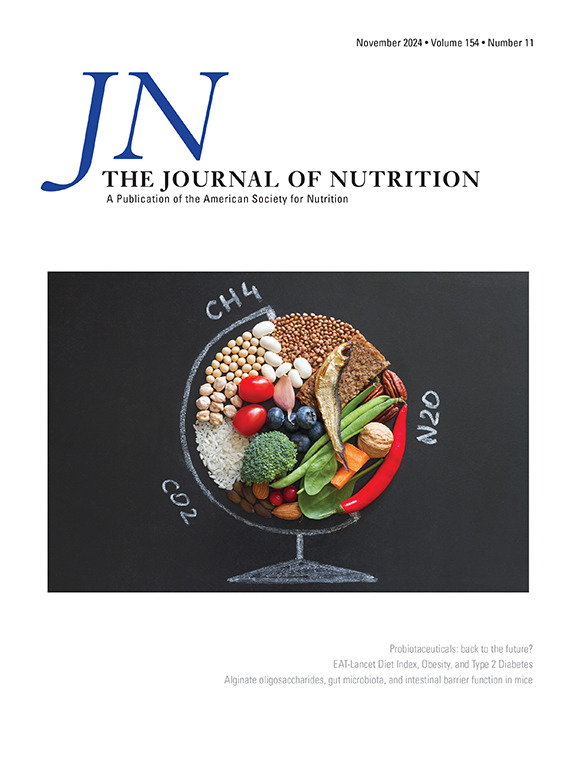Does the Inclusion of Free Sugars as Opposed to Total Sugars in Nutrient Profiling Models Improve Their Performance? A Cross-sectional Analysis From the PREDISE Study
IF 3.8
3区 医学
Q2 NUTRITION & DIETETICS
引用次数: 0
Abstract
Background
Nutrient profiling (NP) models characterize the healthfulness of foods. Few NP models have been validated, and nutrients included in their algorithm do not always reflect the most recent scientific evidence.
Objectives
This study aimed 1) to evaluate the validity of NP models against a diet quality measure and cardiometabolic risk factors in French-Canadians and 2) to compare the validity of each model when replacing total sugars by free sugars in their algorithm.
Methods
The PRÉDicteurs Individuels, Sociaux et Environnementaux cross-sectional study was used to test original and modified versions (i.e., including total or free sugars, respectively) of 3 NP models: Health Star Rating (HSR) system, Nutri-Score, and Nutrient-Rich Food index 6.3. Data from web-based self-administered 24-h recalls completed by 1019 adults were used to calculate energy-weighted NP-derived individual scores for both versions of each model. Associations between individual scores and the Healthy Eating Food Index 2019, as well as 14 biomarkers covering anthropometry, blood pressure, blood lipids, glucose homeostasis, and inflammatory biomarkers, were assessed using multivariable linear models.
Results
Higher quality of foods consumed, as assessed by all 3 original models, was associated with higher Healthy Eating Food Index 2019 (adjusted R2: 0.43–0.55), and with lower body mass index (BMI) (β: from –0.16 to +0.48 kg/m2; P ≤ 0.0001), diastolic blood pressure (β: –0.08 to +0.30 mm Hg; P ≤ 0.04) and triglycerides (β: –0.01 to +0.02 mmol/L; P ≤ 0.002). Original HSR and Nutri-Score were also associated with lower waist circumference and HOMA-IR, lower insulin (HSR only), and higher HDL cholesterol (Nutri-Score only). Replacing total sugars by free sugars in each model only slightly increased the number of associations observed with biomarkers.
Conclusions
All 3 models are associated with diet quality and some biomarkers of health status in French-Canadians, although no model outranks the others. Replacing total sugars by free sugars has little to no effect on NP models’ performance, therefore not supporting this approach for now.
在营养分析模型中加入游离糖而不是总糖是否能提高它们的性能?PREDISE研究的横断面分析。
背景:营养分析(NP)模型表征了食品的健康性。很少有NP模型得到了验证,并且其算法中包含的营养素并不总是反映最新的科学证据。目的:本研究旨在1)评估NP模型对法裔加拿大人饮食质量指标和心脏代谢危险因素的有效性;2)比较每个模型在用游离糖代替总糖时的有效性。方法:采用PRÉDicteurs PREDISE (Individuels, Sociaux et Environnementaux)横截面研究,对健康星级评分(HSR)系统、营养评分(nutrition - score)和营养丰富食品指数(Nutrient-Rich Food index 6.3)三种NP模型的原始版本和修改版本(即分别包括总糖和游离糖)进行测试。由1019名成年人完成的基于网络的24小时自我管理回忆数据被用于计算每个模型的两个版本的能量加权np衍生的个人分数。使用多变量线性模型评估个人得分与健康饮食食品指数(HEFI)-2019之间的关系,以及包括人体测量、血压、血脂、葡萄糖稳态和炎症生物标志物在内的14种生物标志物。结果:根据所有三种原始模型的评估,食用的食品质量越高,HEFI-2019越高(调整R2从0.43-0.55),BMI越低(β从-0.16-+0.48 kg/m2;P≤0.0001),舒张压(β -0.08-+0.30 mmHg;P≤0.04)和甘油三酯(β -0.01 ~ +0.02 mmol/L;P≤0.002)。原始HSR和nutrition - score也与较低的腰围和HOMA-IR、较低的胰岛素(仅HSR)和较高的hdl -胆固醇(仅nutrition - score)相关。结论:所有三种模型都与法裔加拿大人的饮食质量和一些健康状况的生物标志物相关,尽管没有一种模型比其他模型更重要。用游离糖代替总糖对NP模型的性能几乎没有影响,因此目前不支持这种方法。
本文章由计算机程序翻译,如有差异,请以英文原文为准。
求助全文
约1分钟内获得全文
求助全文
来源期刊

Journal of Nutrition
医学-营养学
CiteScore
7.60
自引率
4.80%
发文量
260
审稿时长
39 days
期刊介绍:
The Journal of Nutrition (JN/J Nutr) publishes peer-reviewed original research papers covering all aspects of experimental nutrition in humans and other animal species; special articles such as reviews and biographies of prominent nutrition scientists; and issues, opinions, and commentaries on controversial issues in nutrition. Supplements are frequently published to provide extended discussion of topics of special interest.
 求助内容:
求助内容: 应助结果提醒方式:
应助结果提醒方式:


